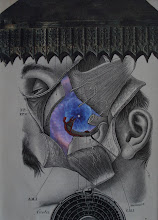As an arts medium, collage has stimulated many great discussions about the nature of creativity and the definition of art. I really love that about collage; and I love discussions about art and creativity. Because it involves the use of original physical elements, analog collage, in particular I think, speaks to something important about art -- uniqueness. I think uniqueness (and it's reciprocal, replicability) is one of the central issues in any discussion of creativity. One of the reasons I switched to collage and assemblage, after being a watercolor painter, years ago; is because I felt that my painting was not especially "creative". I would often use a photograph as a model, and simply reproduce the image in my drawing and watercolor painting. These zebras are a good example. The photographic image on the left, was used as a model to create the painting on the right.
I am proud of this painted recreation of the zebras (it took MANY hours to complete this!), but I felt that paintings like this were not very creative. They weren't tapping into "the new", "the different", "the unique". Additionally, in many ways, this painting could have been replicated by others with the training/talent to do so... including me. And in fact, forgeries of famous paintings always pique people's interest (btw, the video "Art and Craft" is a GREAT documentary of famous forger Mark Landis), and are the bane of many a museum curator.
Uniqueness is one of the hallmarks of collage, -- especially of analog collage (and here I am referring to prohibition of any photocopying, as well). Replicating an analog collage would pose a particularly prickly problem, in that it would require procurement of another set of identical images. Although this is not impossible (especially with contemporary magazines), finding vintage or rare publications of books or magazines can be challenging. And when elements are extracted from their sources, it is sometimes difficult to identify, not to mention, locate those sources. And sometimes I come across, arguably, truly unique elements.
Here's an example. This is a stock certificate for the Thompson Spring Corporation. Not only does it appear to be a somewhat unusual element (rare?), but it is signed in ink by the "powers-that-be". So even if someone else had a stock certificate like this one, it would likely have a signature that was slightly different (small, but significant detail, I think), and most likely not made-out to the same buyer.
I was attracted to this element initially for the standard, intricate border design; but I started experimenting with placements of various other elements (as I typically do in my creative process). When I placed this wine-pouring jester over the certificate, I really liked the integration of the matching patina and the balance of the composition itself (a two-element collage ala British collagist John Stezaker?). And to be honest, I have no recollection of where I obtained the jester element.
I really don't know whether this is a finished piece (although I do like it!). But the point of this post is that I think analog collage is uniquely unique. Analog collages are not only, literally "one of a kind"; but it would often be very to truly replicate... nigh impossible.


























